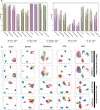Tuning parameters of dimensionality reduction methods for single-cell RNA-seq analysis
- PMID: 32831127
- PMCID: PMC7444048
- DOI: 10.1186/s13059-020-02128-7
Tuning parameters of dimensionality reduction methods for single-cell RNA-seq analysis
Abstract
Background: Many computational methods have been developed recently to analyze single-cell RNA-seq (scRNA-seq) data. Several benchmark studies have compared these methods on their ability for dimensionality reduction, clustering, or differential analysis, often relying on default parameters. Yet, given the biological diversity of scRNA-seq datasets, parameter tuning might be essential for the optimal usage of methods, and determining how to tune parameters remains an unmet need.
Results: Here, we propose a benchmark to assess the performance of five methods, systematically varying their tunable parameters, for dimension reduction of scRNA-seq data, a common first step to many downstream applications such as cell type identification or trajectory inference. We run a total of 1.5 million experiments to assess the influence of parameter changes on the performance of each method, and propose two strategies to automatically tune parameters for methods that need it.
Conclusions: We find that principal component analysis (PCA)-based methods like scran and Seurat are competitive with default parameters but do not benefit much from parameter tuning, while more complex models like ZinbWave, DCA, and scVI can reach better performance but after parameter tuning.
Conflict of interest statement
The authors declare that they have no competing interests.
Figures




References
-
- Kolodziejczyk AA, Kim JK, Svensson V, Marioni JC, Teichmann SA. The technology and biology of single-cell RNA sequencing. Mol Cell. 2015;58(4):610–20. - PubMed
-
- Zeisel A, Muñoz-Manchado AB, Codeluppi S, Lönnerberg P, La Manno G, Juréus A, Marques S, Munguba H, He L, Betsholtz C, et al. Cell types in the mouse cortex and hippocampus revealed by single-cell RNA-seq. Science. 2015;347(6226):1138–42. - PubMed
-
- Tasic B, Menon V, Nguyen TN, Kim TK, Jarsky T, Yao Z, Levi B, Gray LT, Sorensen SA, Dolbeare T, Bertagnolli D, Goldy J, Shapovalova N, Parry S, Lee C, Smith K, Bernard A, Madisen L, Sunkin SM, Hawrylycz M, Koch C, Zeng H. Adult mouse cortical cell taxonomy revealed by single cell transcriptomics. Nat Neurosci. 2016;19(2):335–46. - PMC - PubMed
MeSH terms
Substances
LinkOut - more resources
Full Text Sources

